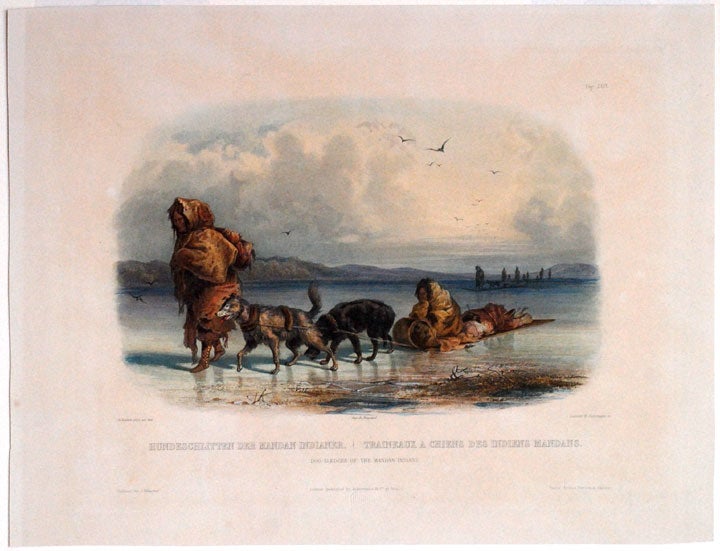BODMER, Karl (1809-1893)
Dog-Sledges of the Mandan Indians.
[Vig. 29] Paris, Coblenz and London: [1839-1842]. Hand-coloured aquatint engraving by Hürlimann after Bodmer, blindstamp. Sheet size: 11 1/2 x 15 1/4 inches.
Bodmer painted this scene during the winter of 1833-4 which he and Prince Maximilian spent at Fort Clark, between the Knife and Heart Rivers in the territory of the Mandans and the Hidatsas. The Mandans had two sites for their main villages: one occupied in the winter, the second in the summer. The scene depicted was probably executed in February when the move from the winter village began. The sledge was constructed from two long flat boards laced together lengthwise with thongs, four slender crossbars provided stability. The front end was bent upwards and secured in place to the body of the sledge by stout leather cords. Dogs were the preferred beast-of-burden over horses as they were lighter (over thin ice and the snow-crust) and apparently had more stamina. Karl Bodmer's images show great versatility and technical virtuosity and give us a uniquely accomplished and detailed picture of a previously little understood (and soon to vanish) way of life. Swiss-born Bodmer was engaged by Prince Maximilian zu Wied-Neuwied (1782-1867) specifically to provide a record of his travels in North America, principally among the Plains Indians. In the company of David Dreidoppel (Prince Maximilian's servant and hunting companion), their travels in North America were to last from 1832 to 1834. Well-armed with information and advice, the party finally left St.Louis, on the most important stage of their travels, aboard the steamer Yellow Stone on April 10 1833. They proceeded up the treacherous Missouri River along the line of forts established by the American Fur Company. At Bellevue they encountered their first Indians, then went on to make contact with the Sioux tribe, learning of and recording their little known ceremonial dances and powerful pride and dignity. Transferring from the Yellow Stone to another steamer, the Assiniboin, they continued to Fort Clark, visiting there the Mandan, Mintari and Crow tribes, then the Assiniboins at Fort Union, the main base of the American Fur Company. On a necessarily much smaller vessel they journeyed through the extraordinary geological scenery of that section of the Missouri to Fort Mackenzie in Montana, establishing a cautious friendship with the fearsome Blackfeet. From this, the westernmost point reached, it was considered too dangerous to continue and the return journey downstream began. The winter brought its own difficulties and discomforts, but Bodmer was still able to execute numerous studies of villages, dances and especially the people, who were often both intrigued and delighted by his work. The portraits are particularly notable for their capturing of individual personalities, as well as forming a primary account of what were to become virtually lost cultures.
Graff 4648; Howes M443a; Pilling 2521; Sabin 47014; Wagner-Camp 76:1.
Item #20073
Price: $1,250.00


